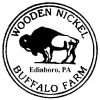Skip to content
Brief History of the American Bison (American Buffalo)
Bison (Buffalo) once roamed the plains in numbers so great the early explorers could not count them. They were described as “numberless”.
Bison have been called the most important wild animals in the development of North America. Bison were the center of life of the Plains for both Native Americans and the settlers.
History note: Buffalo or Indian Head Nickels, 1913-1938, were designed by James A. Fraser. The Indian Head side was designed using three different Native Americans as models: Iron Tail (Sioux), Two Moons (Cheyenne) and John Big Tree (Onandaga). The Buffalo Head side was modeled after Black Diamond, a Bison in the New York Zoological Gardens.
About Bison: Bison bulls can weigh 1,600-2,200 pounds at maturity which is 6-8 years old. They stand up to 6 feet high at the hump and can measure up to 9 feet long from nose to tail. Females are smaller, weighing 900-1,200 pounds, stand 5 feet high and measure 6 feet from nose to tail.
Bison bulls can weigh 1,600-2,200 pounds at maturity which is 6-8 years old. They stand up to 6 feet high at the hump and can measure up to 9 feet long from nose to tail. Females are smaller, weighing 900-1,200 pounds, stand 5 feet high and measure 6 feet from nose to tail.
Though grazing Buffalo appear tame and docile, Bison are wild animals and should be viewed with respect. They may look slow and lethargic, but an agitated Buffalo can outrun a horse. Stay on the outside of the fence with a pasture full of Buffalo!
Buffalo are beautiful & amazing animals. They live 25-40 years & will breed their entire life. They can adapt to any climate on earth. Buffalo are in every state including Alaska and Hawaii. Once an endangered species, the Buffalo are no longer endangered. Buffalo have made a comeback and we are doing our part to preserve some of our great heritage. When Columbus landed in America in 1492, it is estimated that 40-60 million Buffalo roamed North America. In the late 1800’s, the Buffalo herds had dwindled to estimates of 100-1,000 animals. Thanks to ranches and small farms like ours, that number has grown to nearly 400,000 today. As long as demand for the healthy red meat continues, they will continue to be raised responsibly and never become endangered again.
Bison: The Native Beef – Bison are native to North American, beef cattle are not.
Today, Bison is making a comeback as a low-fat alternative red meat and is again being recognized as a valuable source of nutrition. Bison is higher in protein, yet lower in fat, cholesterol and calories than most other meats. Bonus: It tastes great! It is not “gamey” or wild tasting but has a pleasingly sweet and rich flavor. Bison meat is also hypoallergenic and can be eaten by people who are allergic to other red meats. Bison must be cooked differently than beef. The key is to retain moisture by lowering cooking time and temperature.
Bison can be used in your favorite beef recipes, but you can reduce the quantity of Bison as it has a higher food value than beef does.

 Bison bulls can weigh 1,600-2,200 pounds at maturity which is 6-8 years old. They stand up to 6 feet high at the hump and can measure up to 9 feet long from nose to tail. Females are smaller, weighing 900-1,200 pounds, stand 5 feet high and measure 6 feet from nose to tail.
Bison bulls can weigh 1,600-2,200 pounds at maturity which is 6-8 years old. They stand up to 6 feet high at the hump and can measure up to 9 feet long from nose to tail. Females are smaller, weighing 900-1,200 pounds, stand 5 feet high and measure 6 feet from nose to tail.
